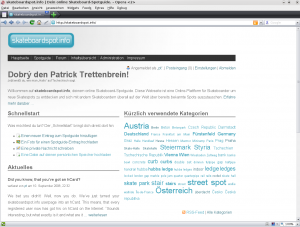Browser Configuration/Opera/da: Difference between revisions
Importing a new version from external source |
Importing a new version from external source |
||
| Line 6: | Line 6: | ||
== 1. skridt: Installation af dekorationen == | == 1. skridt: Installation af dekorationen == | ||
Åbn '''Opera''' og følg dette link: | |||
[http://my.opera.com/community/customize/skins/info/?id=8141 http://my.opera.com/community/customize/skins/info/?id=8141] | [http://my.opera.com/community/customize/skins/info/?id=8141 http://my.opera.com/community/customize/skins/info/?id=8141] | ||
Revision as of 18:07, 27 October 2010
Denne vejledning hjælper dig med at konfigurere Opera, sådan at den passer godt sammen med dine andre programmer til Plasma. For at gøre dette, skal du først installere dekorationen Opera Oxygen Project, indstille Opera til at bruge denne dekoration og ændre Operas standardskrifttyper til dem, som KDE bruger.
1. skridt: Installation af dekorationen
Åbn Opera og følg dette link:
http://my.opera.com/community/customize/skins/info/?id=8141
Click to install the skin.
Step 2: Applying the Skin & Changing the Color Scheme
Go to .
In the Skins box, you will see a list of all the skins that are currently installed. Click on to apply the Opera Oxygen Project skin to Opera.
Click on the menu box next to Color Scheme and select to let Opera use KDE's color scheme.
Step 3: Changing the Font
Go to . Click on the tab.
Opera has two default fonts - the normal font and the monospace font. You can change these default fonts by clicking on them. Change the normal font to DejaVu Sans and change the monospace font to DejaVu Sans Mono.
That's it! Now Opera will look and feel just like your Plasma applications.

Source
This tutorial is based on Patrick Trettenbrein's blog entry entitled “How to make Opera 9.5 look native in KDE 4”. Additional updates have been made as Opera has been updated.

